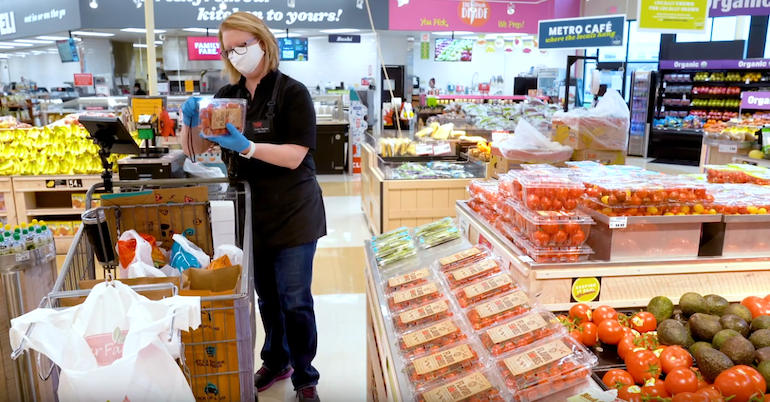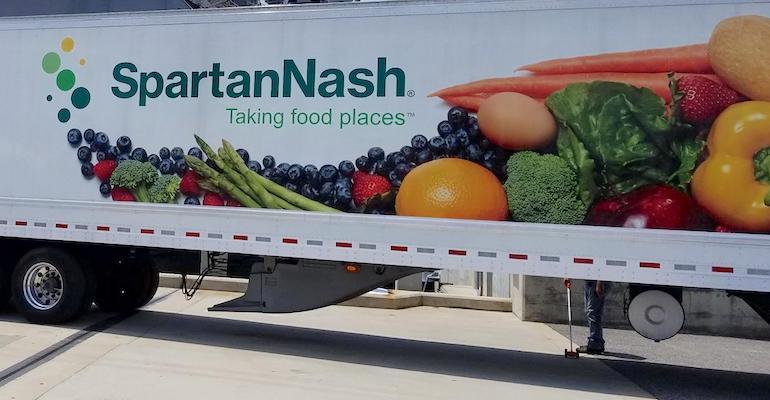Led by food distribution and retail, SpartanNash tallied sales gains in its fiscal 2021 third quarter atop strong COVID-driven growth a year ago.
For the 12-week quarter ended Oct. 9, net sales totaled $2.07 billion, up 0.6% from $2.06 billion a year earlier, SpartanNash reported yesterday after the market close. The Grand Rapids, Mich.-based company noted that decreased sales in its military wholesale unit partially offset higher sales in its food distribution arm and comparable-sales growth in its retail division.
The overall sales gain built on a 3.1% uptick in the fiscal 2020 third quarter and marked a rebound form a 3.6% decrease in the 2021 second quarter. The latter included declines across SpartanNash’s three business units.
“Overall, we’re pleased with our results. We’re up against steep prior-year comparisons, but we managed to grow our top line and meet our profitability objectives,” President and CEO Tony Sarsam told analysts in a conference call on Thursday. “We’ve had solid performance year-to-date, so we feel confident in once again improving our full-year earnings guidance.”
 "We’ve seen the inbound service from our vendors decline by over 10% since the start of the year, with some top suppliers declining by more than 20%." — Tony Sarsam, SpartanNash (Photo courtesy of SpartanNash)
"We’ve seen the inbound service from our vendors decline by over 10% since the start of the year, with some top suppliers declining by more than 20%." — Tony Sarsam, SpartanNash (Photo courtesy of SpartanNash)
The core food distribution segment saw 2021 third-quarter net sales rise 1.9% to $1.03 billion from $1.01 billion in the 2020 quarter, when sales advanced 7.8%. SpartanNash attributed the increase to sales growth with current customers as well as inflation. The company noted that, over two years, food distribution sales are up 9.8%.
“We saw an upward trend in inflation as the quarter progressed, averaging approximately 6% in the quarter,” Chief Financial Officer Jason Monaco said in the call. “This increase included steep hikes in proteins, while center-store grocery product categories increased by about 3%. We still anticipate further increases for the balance of the year. However, as we previously noted, we anticipate that these increases will be passed through and will be accretive overall.”
In the retail unit, net sales edged up 2% to $608.7 million from $596.6 million in the prior-year period, lifted by same-store sales growth and rising fuel sales, partially offset by store closings, according to SpartanNash. Comp-store sales rose 3.1% in the quarter and were up 13.5% on a two-year stack.
Currently, SpartanNash operates 146 supermarkets in the Midwest, primarily under the Family Fare, Martin’s Super Markets, D&W Fresh Market, VG’s Grocery and Dan’s Supermarket banners, down from 156 locations a year earlier.
“We saw retail top-line growth on both a one-year and two-year basis. Our fresh and pharmacy departments’ performance was particularly strong. On a two-year basis, our comps improved sequentially, from 12.1% to 13.5% in the third quarter. This improvement is a result of in-store execution efforts, increased traffic and continued demand for food at home. In addition, we’ve made a slight net price increases that so far have had minimal impact on consumption,” Sarsam said. “In spite of our investments in wages, we manage our expenses carefully in a tight labor market. Our retail segment labor rate improved by 30 basis points compared to the prior-year quarter.”

On a comparable-store basis, sales in SpartanNash's corporate-run supermarkets are up 13.5% over two years through the end of the third quarter.
Military distribution net sales came in at $433.2 million in the third quarter, down 4.1% from $452 million a year ago but less than the 7.1% decrease in the second quarter. SpartanNash said the Q3 decline reflects reduced export sales following last year’s elevated consumer demand, as well as supply chain issues at international shipping ports and continued lower volumes at domestic commissaries. The division’s sales are down 13.2% on a two-year basis.
“In our food and military distribution segments, where labor and supply-chain pressures are most acute, we are seeing some favorable tailwinds. Inflation increases have supported our gross profit improvement and partially offset the difficult headwinds. However, we must do more to mitigate the unprecedented pressures that we and the industry face today,” according to Sarsam.
The global supply chain remains “under unprecedented pressure” amid the pandemic, he told analysts.
“Current labor conditions and inflationary pressures are straining suppliers that are already operating in survival mode throughout this pandemic. In addition to the challenges posed by vendors not fulfilling orders, we’re also facing increased disruption from vendors not showing up timely,” Sarsam explained. “We’ve seen the inbound service from our vendors decline by over 10% since the start of the year, with some top suppliers declining by more than 20%. These types of disruptions are being seen across the entire food distribution industry.”
Despite the unstable business climate, SpartanNash’s 2021 third-quarter earnings per share came in just above Wall Street’s forecast. Net income totaled $15.18 million, or 42 cents per diluted share, compared with $20 million, or 56 cents per diluted share, a year ago. Adjusted earnings (continuing operations), were $15.3 million, or 43 cents per diluted share, versus $25.1 million, or 70 cents per diluted share, in the prior-year period.
Analysts, on average, had projected adjusted EPS of 41 cents for the quarter, with estimates ranging from a low of 30 cents to a high of 45 cents, according to Refinitiv.
Looking ahead, SpartanNash confirmed its adjusted EPS guidance of $1.70 to $1.80 for fiscal 2021 but narrowed its reported EPS projection. The company now estimates GAAP EPS of $1.61 to $1.71 for the year, compared with $1.56 to $1.69 previously. Overall net sales are pegged at $8.8 billion to $9 billion, the same as prior guidance, and the outlook for distribution sales remains at decreases of 1% to 3% for food and 9% to 13% for military.
“We are reaffirming our full-year 2021 guidance as it relates to consolidated net sales,” Monaco said. “However, with the continuation of positive results in the retail segment, we now expect that retail full-year comparable sales will only be negative 1% to 2%, which is an improvement from our previous expectations” of a 2% to 5% decrease.
Wall Street’s consensus estimate is for fiscal 2021 adjusted EPS of $1.78, with projections running from $1.70 to $1.86, according to Refinitiv.





